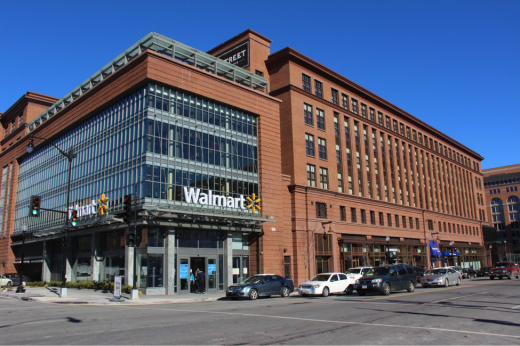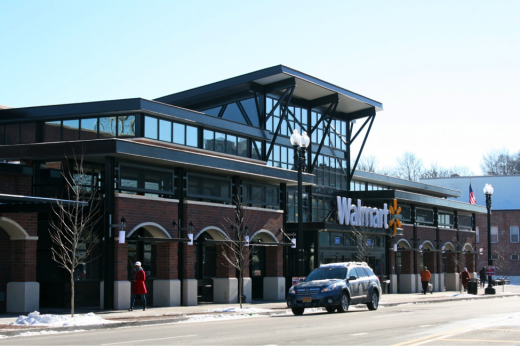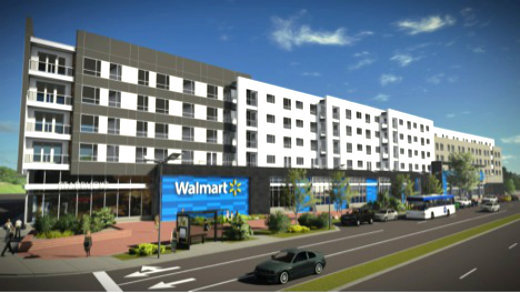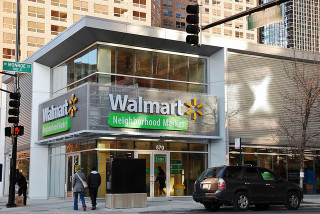Can big box retailers think outside the box?
A few years ago the idea of a pedestrian friendly big box store would have been laughable, but as urban living has become more popular the major chain retailers are paying attention and beginning to build urban format stores. On December 4, 2013 Walmart opened its first two stores in Washington, DC and the new stores illustrate the lengths to which brick and mortar retailers will go to get into rapidly growing urban markets.
Compared to the old “grey-blue battleship box” that has saturated suburban and small town America, the new urban Walmart on H Street, NW in Washington is a remarkable departure.

Whether you love them or loathe them, this building proves that Walmart — one of the most recognizable symbols of modern suburbia — is going urban.
Who ever thought that Walmart shoppers could sleep upstairs and shop downstairs, but that is exactly what residents of the new Walmart near downtown Washington will be able to do.
The 83,000 square ft. store built in partnership with JBG Rosenfeld is in a mixed use building topped by four stories of apartments. Instead of acres of asphalt, the parking is underground. In addition to the Walmart, there is another 10,000 square ft. of retail space wrapped around the outside of the retail giant. Retail tenants currently include a Starbucks and a bank, with more to follow. The residential portion of the building contains 303 apartments, a fitness center, a lounge area, a roof deck, and a swimming pool.

The main store entrance sits right on the sidewalk and shoppers will use an escalator to reach the store level. The store itself offers more groceries than a typical Walmart and the shopping floor is day lighted by real windows.
Designed by MV+A Architects and the Preston Partnership, the H Street Walmart is a handsome urban building with traditional human scale details. It includes cornices, individual multi-pane windows, an interesting corner feature at the main entrance, and a separate entrance for residents. It is a fully urban, pedestrian friendly building. Whether you love them or loathe them, this building proves that Walmart — one of the most recognizable symbols of modern suburbia — is going urban.
While the H Street store is by far the better of the two new urban Walmart’s in Washington, the other new store on Georgia Avenue, NW is also a significant departure from the typical suburban store design. Built on the site of an abandoned car dealership, the Georgia Avenue Walmart is a 102,000 square foot store on a four acre site.

Given the small size of the property, the only way to build a large store was to eliminate surface parking and bring the store right up to the sidewalk. The parking is located in a garage located directly below the store. While the building is not mixed use, it does greet the street and represent a real evolution for Walmart.
The lesson here is that cities that want good design are going to have to demand it.
In addition to the two stores that opened in December, 2013, Walmart has announced plans for four additional stores in Washington. Based on a review of their plans, some will be walkable, urban format stores, others will not. Dan Malouff, a design critic with the Greater Greater Washington blog, says that one will be unquestionably urban, one will be a hybrid, and two will be almost completely suburban. 1 The lesson here is that cities that want good design are going to have to demand it.

Building an Urban Format Store
Can Walmart build an urban format store? The answer appears to be yes, but it also appears that the only thing standard in an urban format big box store is its lack of standardization. Building suburban big box stores is simple. Buy a 20 acre suburban greenfield site. Build a large, free standing rectangular single floor building on a concrete slab. Plop the building in a sea of parking. A Walmart Supercenter in the suburbs of Atlanta, for example, is essentially identical to one in the suburbs of Chicago or Cincinnati. This model simply won’t work in a dense urban area.
The two things that have kept Walmart out of cities were its inflexibility on design issues and opposition from labor unions and civic activists who oppose the company because of its low wages and negative impact on existing local businesses.
Now that it appears that Walmart is willing (when pushed by local government) to adapt its stores to the urban environment, it is likely only a matter of time before the retail giant moves into cities all over the country.

Big Boxes are Getting Smaller
Another thing that is clear is that big boxes are getting smaller. The new 80,000 square ft. Walmart in Washington is half the size of many suburban Supercenters.
What’s more, Walmart is creating new formats uniquely designed for cities. The new Walmart Neighborhood Market, for example, is only 40,000 square feet while the so-called Walmart Express stores are only 15,000 square feet. Walmart has even opened two college stores, at Georgia Tech in Atlanta 2 and at the University of Arkansas in Fayetteville. 3 Each of these stores is less than 5000 square feet in size.
| Store Type | Square Footage | Date Initiated |
|---|---|---|
| Discount Store | 106,000 sq. ft. | 1962 |
| Supercenter | 182,000 sq. ft. | 1982 |
| Neighborhood Market | 38,000 sq. ft. | 1998 |
| Express Store | 15,000 sq. ft. | 2011 |
| College Store | Under 5,000 sq. ft. | 2013 |
Times have changed. The country’s largest retailers have oversaturated rural and suburban communities. The only place left with more spending power than stores is in our cities. Walmart has made its urban debut. The outstanding question remaining is: what impact will Walmart have on local economies and wages?
Washington, DC, City Councilman Phil Mendelson, a co-sponsor of unsuccessful legislation that would have required big box retailers to pay a living wage and benefits, expressed skepticism about the impact of Walmart on the local economy. “I would say, having the world’s largest retailer interested in locating in the city where we’ve lost almost every other department store over the last four decades — that’s a good thing. Having an economic competitor who underprices the market and causes a descent to the bottom, in terms of wages — that is not a good thing.” 4
While Walmart is clearly evolving to fit into cities, there is also evidence that the retail giant is willing to break the mold in smaller towns and suburbs.
What About Smaller Towns & Suburbs?
While Walmart is clearly evolving to fit into cities, there is also evidence that the retail giant is willing to break the mold in smaller towns and suburbs. This is because retail store size is shrinking due to the growth of internet shopping and also because suburbs are changing to stay competitive.
Target, Whole Foods, Safeway, Giant, and other chains are already breaking the rules by building smaller footprint stores in multi-story buildings and mixed use developments.
Walmart has recently opened several small town stores with parking under the building or with solar installations on the roof.
What impact Walmart and other big box retailers will have on cities and the neighborhoods where they locate remains to be seen. Harriet Tregoning, the planning Director in Washington, DC, says that “Walmart does not offer any meaningful shopping experience. It competes solely on price and convenience.” 5 Her message to small businesses is that “if you are in direct competition with Walmart you are in the wrong business to begin with.” Instead she says “businesses that offer something Walmart can’t like bars, restaurants and stores selling specialty goods or offering personalized levels of service — will continue to thrive.”
In some ways, the idea of national chains opening big new urban stores is a return to the way things once were. In 1960, we called it department store. Today we call it a Walmart.
Ed McMahon is one of the country’s most incisive analysts of planning and land use issues and trends. He holds the Charles Fraser Chair on Sustainable Development and is a Senior Resident Fellow at the Urban Land Institute in Washington, DC. McMahon is a frequent speaker at conferences on planning and land development.
Over the past 21 years, we’ve been pleased to have published more than two dozen articles by McMahon in the Planning Commissioners Journal, and now on PlannersWeb.com.
Notes:
- Dan Maloutt, “Walmart’s 6 DC stores: Some will be urban, some won’t” (Greater Greater Washington blog, April 26, 2012) ↩
- Allison Brooks, “The world’s tiniest Walmart opens in Atlanta” (Atlanta Magazine, Aug. 14, 2013 ↩
- Todd Gill, “Now open: Walmart on Campus” (Fayetteville Flyer, Jan. 14, 2011). ↩
- Ryan Holeywell, “Walmart Makes Its Urban Debut” (Governing Magazine, June 2012) ↩
- Id. ↩